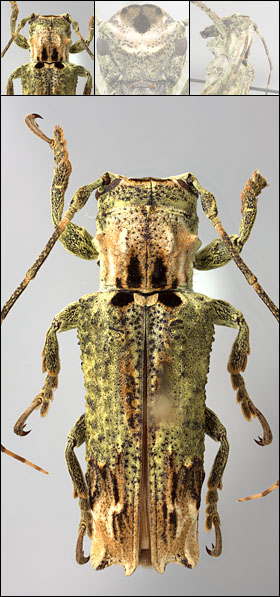 |
 Previous Genus Next Genus Previous Genus Next Genus 
Genus: Ecthoea
Diagnostic Features
- Description: Elongate-oblong, robust, small to large-sized, ranging from about 8–22 mm in length. Integument generally dark brown with whitish, ochraceous, black, and greenish pubescence.
 Head with frons transverse, narrower below eyes, about as wide as width of four lower eye lobes; frons surface roughly sculptured or not. Entire surface of head often finely punctate, each puncture bearing a fine scale in its center. Eyes with lower lobes small, ovate. Genae elongate, about as tall to distinctly taller than lower eye lobes. Antennal tubercles prominent, widely separated; tubercles not armed at apex (females) or armed with a moderately long, acute horn (males); antennae about as long as overall body length (females), or as much as 1 1/2 times as long (males); scape clavate, about as long or shorter than antennomere IV; antennomere III nearly straight or curved, longer than scape and antennomere IV. Pronotum transverse, roughly cylindrical, slightly narrower at base, with lateral tubercles. Elytra with sides roughly parallel; elytral apices individually bidentate; elytra generally greenish with distinct areas of contrasting color; base of elytra with several prominent, irregularly shaped, rough, blunt tubercles at humeri. Basal 1/3 of elytra moderate to dense punctation, surface coarsely punctate to granulate-punctate. Procoxae without projection. Mesosternal process with apex subtruncate to feebly emarginate. Metafemora short in length, about 1/4–1/5 as long as elytra. Head with frons transverse, narrower below eyes, about as wide as width of four lower eye lobes; frons surface roughly sculptured or not. Entire surface of head often finely punctate, each puncture bearing a fine scale in its center. Eyes with lower lobes small, ovate. Genae elongate, about as tall to distinctly taller than lower eye lobes. Antennal tubercles prominent, widely separated; tubercles not armed at apex (females) or armed with a moderately long, acute horn (males); antennae about as long as overall body length (females), or as much as 1 1/2 times as long (males); scape clavate, about as long or shorter than antennomere IV; antennomere III nearly straight or curved, longer than scape and antennomere IV. Pronotum transverse, roughly cylindrical, slightly narrower at base, with lateral tubercles. Elytra with sides roughly parallel; elytral apices individually bidentate; elytra generally greenish with distinct areas of contrasting color; base of elytra with several prominent, irregularly shaped, rough, blunt tubercles at humeri. Basal 1/3 of elytra moderate to dense punctation, surface coarsely punctate to granulate-punctate. Procoxae without projection. Mesosternal process with apex subtruncate to feebly emarginate. Metafemora short in length, about 1/4–1/5 as long as elytra.
- The combination of the following characters will help to distinguish this genus: distinctly small eyes, widely separated; roughly cylindrical pronotum; elytra with sides roughly parallel; individually bidentate elytral apices; and short metafemora.
- Similar genus/genera: this genus is distinct among Onciderini and the only genus with bidentate elytral apices.
Geographic Distribution
- Central America (Costa Rica, Panama)
- South America (Brazil, Ecuador, French Guiana, Guyana, Peru, Suriname, Trinidad & Tobago)
Host Plants/Trees
- Myrtaceae (Eugenia stipitata); Rubiaceae (Coffea arabica [coffee]); Sterculiaceae (Theobroma cacao [cocoa])
Girdling Behavior
- This species is known to girdle branches (Delgado & Couturier, 2004) and in Peru is commonly referred to as "serruchador" ["one who saws" or "sawyer"].
- Specimens of this genus have been reared from girdled branches.
Notes
Generic Synonymies
- The type species of this genus was originally described in the genus Cerambyx; the genus Talasius was synonymized with Ecthoea.
Selected References
|
 |
 
Ecthoea quadricornis
♀ specimen
© E.H. Nearns
|
© 2011-2015 Nearns, E.H., Lord, N.P., and K.B. Miller
The University of New Mexico and Center for Plant Health Science and Technology, USDA, APHIS, PPQ.
|


